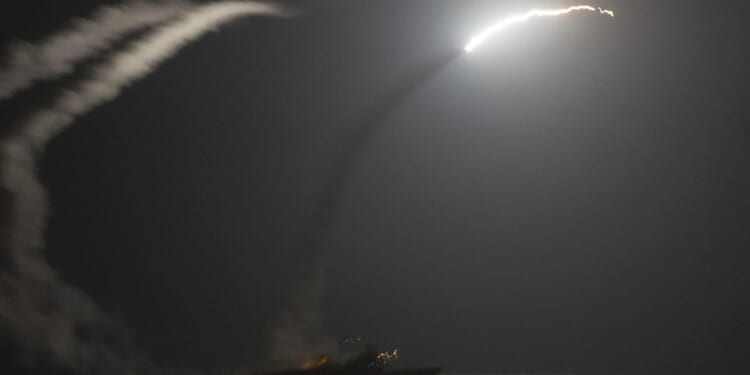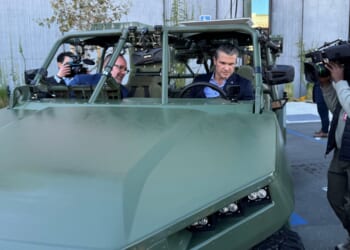In spite of his bluster on Ukraine, Trump has no real desire for war—and Putin understands this reality.
It is almost a year to the day when then-candidate Donald Trump told rapt audiences around the country that he would get a resolution to the end of the Ukraine War “on Day One.” At other times throughout the contentious 2024 presidential election cycle, Trump would huff that the Ukraine War would have never happened had he been president in February 2022, when the Russians invaded Ukraine.
And in just one year’s time, since being sworn in, Trump has gone from belittling Ukraine’s military position in the ongoing war with Russia—famously claiming to Ukrainian President Volodymyr Zelenskyy that he “[didn’t] have the cards” to continuing the war—to claiming instead that Ukraine could reclaim all its lost territory. In fact, Trump made a series of bizarre pronouncements that represent a seemingly significant reversal in his longtime commitment to peace with Russia over the Ukraine War.
Trump as an Agent of Chaos
In a series of diplomatic punches, Trump announced in short order that he was authorizing US targeting intelligence to be used to assist Ukraine in targeting sensitive Russian energy sites within Russia. After that, in the wake of what appeared to be a series of Russian incursions into NATO airspace, Trump decreed that European members of NATO should shoot down the next Russian warplane that dared to infringe upon their airspace.
Rounding out Trump’s apparent change of heart, the 47th president intimated that he might send America’s vaunted Tomahawk cruise missiles to Ukraine so that those weapons can be used to more effectively attack targets within Russia.
It is doubtful that Trump is truly interested in expanding the already expansive (and expensive) Ukraine War beyond what it has already been expanded to. In fact, some experts, even those who support increasing American military aid to Ukraine, have acknowledged to Reuters that the chances of Trump actually sending Tomahawks to Ukraine are slim. There are a variety of reasons for this, partly because, despite whatever Trump might say publicly, there is little appetite on his end to abandon his previous stance about bringing peace to Ukraine and resetting relations with Russia.
Trump Wants to Force Putin to the Table—but Probably Can’t
There is some evidence that even suggests all these rhetorical flourishes from Trump are being made out of understandable frustration over the glacial pace at which peace negotiations between Ukraine and Russia have proceeded. Realizing that Zelenskyy is inflexible, and that, so long as Russia continues winning the war, Vladimir Putin is disinterested in real negotiations, Trump is seeking to acquire leverage.
A man who fancies himself as the dealmaker-in-chief, who (ostensibly) wrote The Art of the Deal, and who made gobs of money in the cutthroat world of Manhattan real estate, Trump is keenly aware of the importance of leverage. Right now, he doesn’t have it—and he wants it. And Trump certainly doesn’t want to send more equipment and money to the black hole that is Ukraine. But he thinks that by threatening to do so, in a clear reversal of his previous stance, it will nudge Putin into a more conciliatory position.
But it will not. Putin, a strategist by professional and academic training, has a much better understanding of the conditions on the ground than do his Western rivals. Indeed, the more Trump blusters with no significant way to back it up, the less inclined the Kremlin will be to fear each subsequent threat. And the emptiest threat that Trump has made thus far as part of his quest for greater leverage over Russia is the insinuation that he would hand over America’s Tomahawk cruise missiles to Ukraine.
Why Tomahawk Missiles Are Not Going to Ukraine
Any military analyst, either in Washington or Kyiv or Moscow, knows how ridiculous this statement is.
For starters, Ukraine simply lacks the launch systems needed for these weapons. Tomahawks are primarily launched from warships and submarines belonging to the US Navy. They are also fired from US Air Force B-52 Stratofortress bombers—none of which Ukraine possesses, or could even easily integrate into their smorgasbord of modern NATO and repurposed Soviet-era equipment.
Could Ukraine adapt the Tomahawk for ground use? Probably, given enough time and effort; the Ukrainians have already jury-rigged other weapons for alternative roles. But adapting ground-based systems (like the existing Aegis Ashore in Poland) would likely require extensive modifications, training, and direct US personnel involvement. That would not only take far too long, and cost Ukraine in resources. There is also the danger that it would be viewed by Moscow as a serious escalation—which would in turn prompt a severe and direct response against NATO. Paradoxically, such a strike is ultimately what Zelenskyy, and many in Brussels, are hoping for, in order to invoke Article 5 of the North Atlantic Treaty and force Trump to more fully commit US forces to Ukraine’s fight.
On the topic of escalation, the missiles rely on US-controlled targeting data and GPS—meaning Ukraine couldn’t use them without Pentagon approval. What is the Kremlin to make of that?
Then there’s the all-important matter of logistics. The United States has a very finite stockpile of Tomahawks, which have been prioritized for potential conflicts in the Middle East and Venezuela—both of which are expected to go kinetic in the near future. Depleting this limited supply for an open-ended and expansive commitment in Ukraine would weaken US readiness.
Since production on these missiles ramps up slowly—with hundreds made per year, at best—there is simply no realistic way the Americans could ever make enough Tomahawk cruise missiles to both support their own national strategic needs as well as the never-ending demand from Ukraine.
Moscow has emphatically stated that they view the Tomahawks to Ukraine as a “red line,” warning that they would equate it to direct US involvement—potentially leading to significant upward movement on the “escalation ladder,” moving the world one rung closer to nuclear Armageddon. Of course, Russia has drawn other “red lines” before, and did little when they were crossed. But there is no good reason for Trump to push his luck.
Trump Probably Won’t Follow Through on the Tomahawk Threat
In any case, Trump’s history of behavior in these situations shows a pattern of bold statements for leverage without any significant follow-through. This is why his political opponents in the Democratic Party have nicknamed him “TACO” (Trump Always Chickens Out); the idea goes that when the cards are down, Trump’s actions rarely live up to his boasts.
While that moniker is mostly unfair, the fact remains that, whether in the trade war against China—which Trump is scrambling to get out of at all costs—or his previous threats in the first term against North Korea, Trump has no real desire for war. Putin understands this reality. Trump would be better served simply saying nothing and scaling back US support for Ukraine—so that he can focus on securing the Western Hemisphere and completing the Golden Dome national missile defense shield.
About the Author: Brandon J. Weichert
Brandon J. Weichert is a senior national security editor at The National Interest. Recently, Weichert became the host of The National Security Hour on America Outloud News and iHeartRadio, where he discusses national security policy every Wednesday at 8pm Eastern. He is also a contributor at Popular Mechanics and has consulted regularly with various government institutions and private organizations on geopolitical issues. Weichert’s writings have appeared in multiple publications, including The Washington Times, National Review, The American Spectator, MSN, The Asia Times, and others. His books include Winning Space: How America Remains a Superpower, Biohacked: China’s Race to Control Life, and The Shadow War: Iran’s Quest for Supremacy. His newest book, A Disaster of Our Own Making: How the West Lost Ukraine is available for purchase wherever books are sold. He can be followed via Twitter @WeTheBrandon.
Image: Wikimedia Commons.

















